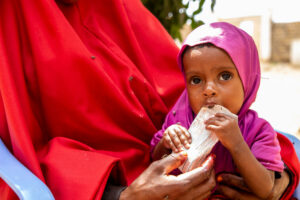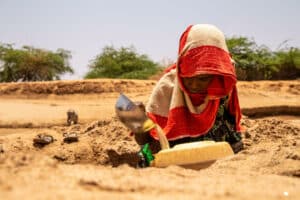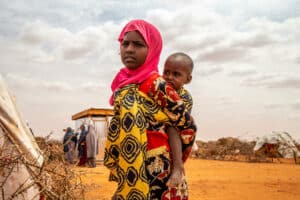Being in a chronic state of emergency, Somalia is not often in the news as a place where people celebrate. Then how come Sandra Kabiru, the country coordinator from World Vision international, is calling for a celebration? After a six-month Acute Response, launched due to prolonged drought, Kabiru offers a positive message as the response comes to a close.
When Localisation Works
Karibu noted in her closing presentation that the investment the Dutch Relief Alliance partners have made in localisation are truly shining through. This Joint Response is the second Acute Joint Response the Dutch Relief Alliance has launched in Somalia as in the past decade the country has faced three severe droughts. The goal of the response was to provide support to internally displaced people affected by drought and conflict through water, food, multi-purpose cash and hygiene kits.

During the recent Joint Response great emphasis was put on the capacities of partners in Somalia. By making localisation a priority the previous connections established in the first Acute Joint Response were further strengthened. Thanks to these efforts, the emergency response became more efficient, flexible, and adaptable to the complex crisis. As one staff member remarks, “due to the Joint Response collaboration, we have managed to secure strategies to implement our project smoothly and effectively to the communities most in need”.
 One of the most notable and direct effects of localisation was the question of access. In previous years accessing certain remote areas was challenging, resulting in some badly affected areas not receiving the necessary assistance. However, in 2022 Kabiru states many areas such as “the Burhakaba District were reachable, meaning aid could be delivered to the rural populations, reducing displacement to urban areas of the country.” This change occurred as the response was spearheaded by the partners working in Somalia, who had a greater understanding of the needs and crisis. When talking to people in the drought affected area, they expressed their satisfaction with the roll out of the programme: “We were affected by the drought we could not have all the needs at once, we used the money meant to buy water to buy other basic needs for the family”. Kabiru echoes this by stating the multi-purpose cash was a great way to stimulate greater investments and faster recovery of the economy.
One of the most notable and direct effects of localisation was the question of access. In previous years accessing certain remote areas was challenging, resulting in some badly affected areas not receiving the necessary assistance. However, in 2022 Kabiru states many areas such as “the Burhakaba District were reachable, meaning aid could be delivered to the rural populations, reducing displacement to urban areas of the country.” This change occurred as the response was spearheaded by the partners working in Somalia, who had a greater understanding of the needs and crisis. When talking to people in the drought affected area, they expressed their satisfaction with the roll out of the programme: “We were affected by the drought we could not have all the needs at once, we used the money meant to buy water to buy other basic needs for the family”. Kabiru echoes this by stating the multi-purpose cash was a great way to stimulate greater investments and faster recovery of the economy.
All in all, the Somalia Joint Response has achieved its goal and, therefore, Kabiru sees the closing of the Joint response as a moment of celebration: “because lives were saved as a result of the successful response. Communication, collaboration and coordination contributed to the success of the response. Resources were used efficiently; stakeholders were engaged, including government, clusters, gatekeepers and project participants, and Somalian partners led the response.
Temporary celebration?

Though Kabiru emphasised the many success stories from the Joint Response and celebrated them, she also states that seeing the nature of the protracted crisis in Somalia, we have to find ways in which to solidify the gains achieved by the Joint Response by layering it with development goals. Only by achieving so can we strengthen the humanitarian – development nexus. The crises in Somalia are by no means resolved, the feeling of celebration the success might be temporary, due to the many challenges that remain.
Photo: World Vision International
Save the Children
Laan van Nieuw Oost-Indië 131-k
2593 BM Den Haag
The Netherlands
Chair organisation: Plan International
E: office@dutchrelief.org